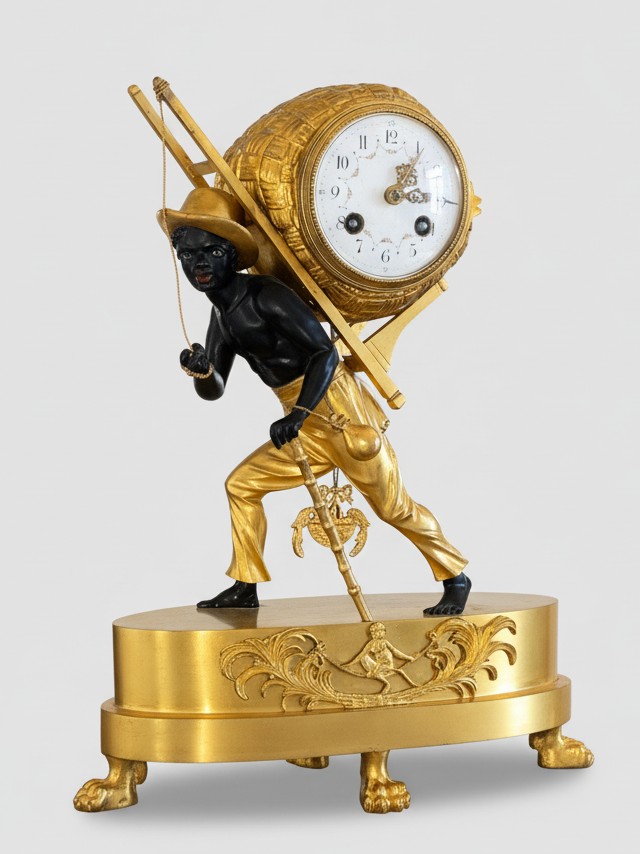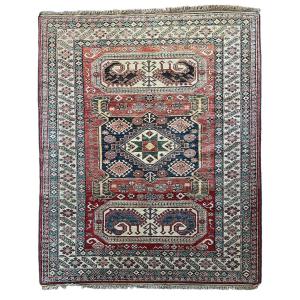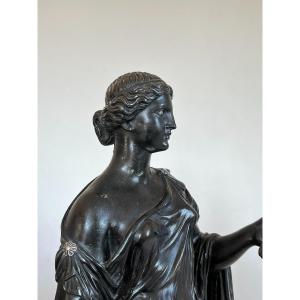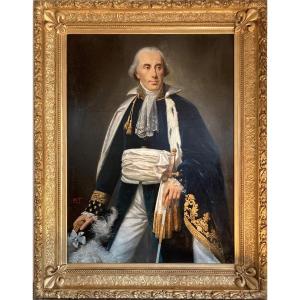Empire Period – Paris, circa 1810
Gilt and Patinated Bronze
Dimensions: Height 36 cm Width 29 cm Depth 12 cm
The composition depicts a servant wearing baggy trousers and a wide-brimmed colonial-style hat. The whole is made of partially gilt and patinated bronze, creating a striking contrast between the original mercury-gilt bronze and the deep matte black patina. The figure is depicted walking, carrying a heavy load on his back, which he is bent under: a bale of goods (coffee, cotton, or sugar), which houses the clockwork and the enameled dial with Roman numerals. He leans on a stick, adding a realistic dynamic to the scene. The white enamel dial is richly decorated with a garland of flowers, with Roman numerals for the hours. The base is oval in shape, entirely gilded, and rests on lion's paw feet, typical of the Empire style.
A very beautiful and highly sought-after French Empire period clock, made after a design by the bronze artist Jean-André Reiche. The model was registered in January 1808, and the watercolor drawing created for this occasion is preserved in the collections of the Musée des Arts Décoratifs in Paris (see photo). The novelty of this composition lies in the fact that the figure is standing, and the clock mechanism is part of the figure, allowing the clock to be seen from all sides.
This type of clock is part of a group called "Negro clocks," a highly prized subject in the French decorative arts of this period, particularly influenced by the myth of the "Noble Savage" and the exoticism associated with trade and the colonies. The contrast between the matte black patina of the figure's body and the shiny gilt bronze of his trousers, hat, dial, and base is a major aesthetic characteristic of these clocks.
While the 18th century was marked by a strong craze for exoticism, it was the Far East that held the favor of decorative arts until around 1775-1780. With the spread of the ideals of the Enlightenment, particularly those of Jean-Jacques Rousseau, and the publication of the novel Paul et Virginie by Bernardin de Saint Pierre, ornamentalists then turned to America and especially Africa. Far from stopping with the Revolution, the craze for noble savage clocks continued and came to an end around 1825. Thus, it was under the Directory and the Empire that the most beautiful models were executed.
The creation of this type of clock requires the involvement of several artisans: the ornamentalist will design the model; then the bronze worker will cast and chisel the clock case; the gilder will then bring the bronze to life, combining mercury gilding and a matte patina; finally, the clockmaker will provide the mechanism and dial.
Jean-André Reiche (1752-1817) was one of the leading Parisian bronze workers of the Empire period. Like Jean-Simon Deverberie, he achieved particular renown for his "Pendules au nègre" (Negro Clocks). The son of a Leipzig merchant, Reiche settled in Paris, where he was received as a founding master in June 1785. From his workshop on Rue Notre-Dame-de-Nazareth, he specialized in the production of clock cases, a business that flourished particularly after the abolition of guilds during the French Revolution. This meant that Reiche could now create every aspect of a clock case, employing a team of workers including modelers, founders, and marble workers. He was renowned both as a bronze merchant and manufacturer and, above all, as a supplier to the Emperor. Upon his death on March 18, 1817, Jean-André Reiche left his business to his son, Jean Reiche.
Similar clocks can be found in major museums, including the Spanish royal collections, the Musée des Arts Décoratifs in Paris, and the collections of the Musée d'Art et d'Histoire in La Rochelle.
Literature :
- Pierre Kjellberg, "Encyclopédie de la Pendule Française du Moyen Age au XXe Siècle," 1997, p. 343;
- Elke Niehüser, "Les horloges françaises en bronze," 1997, pp. 149-240;
- Spanish Royal Collection, "Catalog of Watches of the National Heritage," 1987, p. 118;
- Tardy II, p. 358.1;
- Giacomo and Aurélie Wannenes - The Most Beautiful French Clocks, p. 312;
- Elke Niehüser - French Bronze Clocks, p. 240.
Conservation Condition :
Piece in good condition.
The mercury-gilt bronze is in perfect condition and of very fine quality. The original patina offers a beautiful contrast, particularly on the lips and eyes, which have retained their luster.
The dial and movement (non-functional) were replaced at the end of the 19th century.
The letter held by the wearer in his right hand is missing.
Sold as is














































 Le Magazine de PROANTIC
Le Magazine de PROANTIC TRÉSORS Magazine
TRÉSORS Magazine Rivista Artiquariato
Rivista Artiquariato